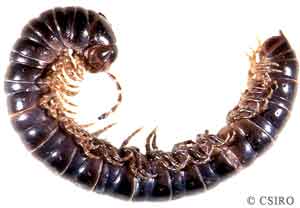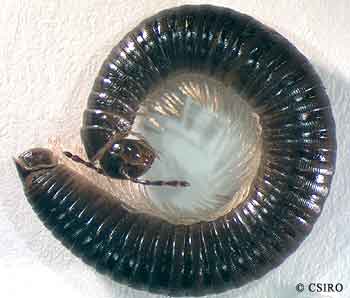|
Diplopoda: millipedes Characteristics
Although it looks like millipedes have 2 pair of legs on each segment, closer examination shows that each body segment is actually 2 segments fused together. Millipedes are timid invertebrates and unlike centipedes, do not have poisonous claws so to protect themselves and to discourage predators they roll into a tight spiral and often discharge a foul smelling, distasteful substance. The introduced species Ommatoiulus moreletii (Black Portuguese millipede), often reaches plague proportions in southern Australia invading houses and destroying crops. Numbers can be so great in places that the ground appears a wriggling mass of black millipedes. Life Cycle
Feeding
Habitat
The black Portuguese millipede Ommatoiulus moreleti, is an introduced species which has rapidly gained a reputation for being a nuisance pest in most areas where it occurs. This species often reaches plague numbers especially in southern Australia. In these instances it often invades houses and other dwellings where it contaminates food and infests carpet and bedding. It may also destroy fruit and vegetable crops. Like other species of Julid millipedes the black Portuguese millipede discharges a yellowish liquid when disturbed to discourage predators. Although not dangerous to humans this fluid can stain skin and material. |


